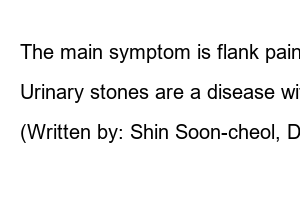비타민 C 과다 복용In particular, vitamin C is an essential nutrient that functions as an antioxidant, iron absorption, and connective tissue formation and function maintenance. Since it is not synthesized in our body, it is recommended to supplement it from outside. For this reason, many people regularly consume vitamin C through nutritional supplements.
However, if you consume more than 1000 mg per day, you are at high risk for urinary stones. This is 10 to 30 times more than the recommended daily intake of 100 mg of vitamin C for Korean adults, and some believe that there is no problem with excessive intake as it is excreted in urine. However, you must be careful as it can be the main cause of urinary stones.
Urinary stones are a urological disease in which stones form in the kidneys, ureters, bladder, and urethra, which are the organs where urine is produced and released. Vitamin C generates oxalic acid during its metabolism. At this time, calcium oxalate, which is formed when oxalic acid, a metabolite of vitamin C, and calcium meet, causes stones.
Not only excessive intake of vitamin C, but also increased meat intake can increase the excretion of calcium, oxalic acid, and uric acid in the urine, increasing the risk of urinary stones. Reduction of body moisture also plays a major role. If you are dehydrated, urinary stone crystals stay in the urine for a long time, which increases the formation of urinary stones.
The main symptom is flank pain that is severe enough to require a visit to the emergency room. In men, it extends to the lower abdomen, testicles, and scrotum, and in women, it extends to the pubic area. It is characterized by an intermittent form that lasts for tens of minutes to several hours and then disappears and then reappears. If the pain is severe, it is accompanied by vomiting, abdominal pain, and abdominal distension, and hematuria due to stones may also occur. When a stone settles near the bladder, bladder irritation symptoms such as frequent urination and residual urination appear.
If the ureters and kidneys are blocked if not treated in time, the flow of urine can be blocked and the kidneys become filled with water, which can lead to hydronephrosis. If it is accompanied by a urinary tract infection, the risk of pyelonephritis and sepsis increases, so it must be treated early. Treatment includes waiting therapy, drug therapy, and extracorporeal shock wave lithotripsy, depending on the intensity of each individual’s pain and the size of the stone.
Urinary stones are a disease with very frequent recurrence. If you have experienced it even once, it is helpful to know about nearby medical institutions that can provide 24-hour emergency treatment for urinary stones. At this time, it is necessary to check whether appropriate detailed examination equipment is in place and whether management programs are operated to prevent recurrence.
Urinary stones are a urinary disease that can occur in anyone, regardless of gender. Nowadays, a comfortable and hygienic environment is basic, and some places have separate waiting areas and treatment lines for men and women, so anyone should not hesitate to visit the hospital if they suspect a urinary disease.
(Written by: Shin Soon-cheol, Director of Uijeongbu Sangseung Urology Clinic)

